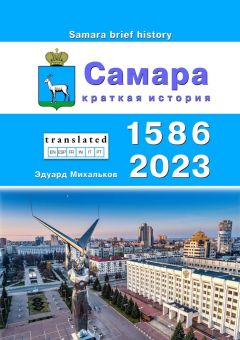Текст книги "Самара. Краткая история"

Автор книги: Эдуард Михальков
Жанр: Документальная литература, Публицистика
сообщить о неприемлемом содержимом
Текущая страница: 1 (всего у книги 2 страниц) [доступный отрывок для чтения: 1 страниц]
Самара. Краткая история
Эдуард Михальков
© Эдуард Михальков, 2023
ISBN 978-5-0060-5267-3
Создано в интеллектуальной издательской системе Ridero
RU
В 1586 году город Самара был основан царем Федором Ивановичем, и начал свою историю как крепостной город на защите южных границ Русского государства.
В XVII—XIX веках Самара стала важным торгово-промышленным центром на Волге, здесь процветало ремесло и торговля. В 1851 году город стал столицей Самарской губернии.
В конце XIX – начале XX века Самара стала одним из крупнейших транспортных узлов Волго-Уральского региона, благодаря активному развитию железнодорожных и водных путей сообщения.
В 1935 году Самара была переименована в Куйбышев в честь революционера Валерия Куйбышева и стала одним из ключевых промышленных центров Советского Союза.
В годы войны, Куйбышев играл важную роль как основной центр производства танков, самолетов и военной техники.
В 1991 году город восстановил свое историческое имя – Самара.
К 2020 году население города превысило 1,1 миллиона человек.
В XVI веке была построена Самарская крепость, включающая в себя каменные и деревянные укрепления, охранявшие границы Русского государства.
В разные периоды были построены значимые религиозные сооружения, такие как Храм Воздвижения Креста Господня и Спасо-Преображенский собор, которые до сих пор служат культурными и религиозными символами города.
Один из самых значимых мостов – Куйбышевский мост, построенный в 1935 году через Волгу, является одним из крупнейших в Европе и важным элементом городской инфраструктуры.
Телеграф и почта: В конце XIX века начали работу первые телеграфные и почтовые службы, обеспечивавшие связь города с другими регионами.
В начале XX века телефонные линии распространились по городу, обеспечивая новые возможности коммуникации.
С начала XX века разработки в области радио связи привели к возникновению первых радиостанций, а в 1950-х годах в Самаре началась трансляция телевизионных программ.
С развитием компьютерных технологий в 1990-х годах интернет стал доступен жителям Самары, и с тех пор стал неотъемлемой частью повседневной жизни.
Первые водопроводные системы начали строить в начале XX века, обеспечивая городское население чистой питьевой водой.
В 1914 году началось строительство канализационной системы, что сделало значительный вклад в улучшение санитарных условий города.
В 1920-х годах были проложены первые газопроводы, обеспечившие газоснабжение домов и предприятий.
В 1930-х годах город активно развивал электрификацию, что способствовало улучшению жизни жителей.
В 1890-х годах начали курсировать первые трамваи, а позже введены автобусы и маршрутные такси, облегчившие передвижение по городу
В 1850 году население Самары составляло около 12 тысяч человек.
К 2020 году население города превысило 1,1 миллиона человек, что делает Самару одним из крупнейших городов в России.
Промышленность:
В XVII—XIX веках Самара стала важным торгово-промышленным центром на Волге. Здесь процветало ремесло и торговля, искусство обработки металла, текстильное производство, производство обуви и кожаных изделий. Значительно развивались мельницы и пивоварни.
В 1851 году Самара стала столицей Самарской губернии и дальше активно развивала свою промышленность. В конце XIX – начале XX века город стал одним из крупнейших транспортных узлов Волго-Уральского региона. Благодаря активному развитию железнодорожных и водных путей сообщения, здесь были созданы крупные предприятия, занимающиеся судостроением, машиностроением и обрабатывающей промышленностью.
В 1935 году Самара была переименована в Куйбышев в честь революционера Валерия Куйбышева и стала одним из ключевых промышленных центров Советского Союза. В годы Второй мировой войны, Куйбышев играл важную роль как основной центр производства танков, самолетов и военной техники.
В послевоенные годы и в период развития современной России, промышленность Самары продолжала развиваться и совершенствоваться. Особое внимание уделялось автомобильной, авиационной и космической отраслям. Здесь разместились крупные автомобильные заводы, как «АвтоВАЗ» – крупнейший автопроизводитель в России, а также предприятия, специализирующиеся на производстве авиационной и ракетно-космической техники.
EN
In 1586, the city of Samara was founded by Tsar Fedor Ivanovich, and began its history as a fortress city to protect the southern borders of the Russian state.
In the XVII-XIX centuries, Samara became an important commercial and industrial center on the Volga, crafts and trade flourished here. In 1851 the city became the capital of Samara province.
In the late XIX – early XX century, Samara became one of the largest transportation hubs of the Volga-Ural region, thanks to the active development of railroad and waterways.
In 1935, Samara was renamed Kuibyshev in honor of the revolutionary Valery Kuibyshev and became one of the key industrial centers of the Soviet Union.
During the war years, Kuibyshev played an important role as a major center for the production of tanks, aircraft and military equipment.
In 1991, the city restored its historical name, Samara.
By 2020, the city's population exceeded 1.1 million people.
In the 16th century, the Samara Fortress was built, including stone and wooden fortifications that guarded the borders of the Russian state.
In different periods significant religious buildings were built, such as the Church of the Exaltation of the Holy Cross and the Cathedral of the Transfiguration of the Savior, which still serve as cultural and religious symbols of the city.
One of the most important bridges, the Kuibyshev Bridge, built in 1935 across the Volga River, is one of the largest in Europe and an important element of the city's infrastructure.
Telegraph and Post: In the late 19th century the first telegraph and postal services began to operate, providing communication between the city and other regions.
In the early twentieth century, telephone lines spread throughout the city, providing new communication possibilities.
Since the beginning of the XX century, developments in radio communications led to the first radio stations, and in the 1950s Samara began broadcasting television programs.
With the development of computer technology in the 1990s, the Internet became available to the residents of Samara, and has since become an integral part of everyday life.
The first water supply systems began to be built in the early 20th century, providing the city's population with clean drinking water.
In 1914, construction of a sewage system began, which made a significant contribution to improving the sanitary conditions of the city.
In the 1920s, the first gas pipelines were laid, providing gas supply to homes and businesses.
In the 1930s, the city actively developed electrification, which contributed to improving the lives of residents.
In the 1890s, the first streetcars began to run, and later buses and shuttle buses were introduced, making it easier to get around the city
In 1850, the population of Samara was about 12 thousand people.
By 2020, the city's population exceeded 1.1 million people, making Samara one of the largest cities in Russia.
Industry:
In the 17th and 19th centuries, Samara became an important commercial and industrial center on the Volga River. Crafts and trade, the art of metalworking, textile production, shoe and leather goods manufacturing flourished here. Mills and breweries developed significantly.
In 1851 Samara became the capital of Samara province and further actively developed its industry. In the late XIX – early XX century the city became one of the largest transportation hubs of the Volga-Ural region. Thanks to the active development of railroad and waterways, large enterprises engaged in shipbuilding, machine building and manufacturing industry were established here.
In 1935 Samara was renamed Kuibyshev in honor of the revolutionary Valery Kuibyshev and became one of the key industrial centers of the Soviet Union. During World War II, Kuibyshev played an important role as a major center for the production of tanks, aircraft and military equipment.
In the post-war years and during the development of modern Russia, Samara's industry continued to develop and improve. Special attention was paid to the automobile, aviation and space industries. Large automobile plants, such as AvtoVAZ, the largest automobile manufacturer in Russia, as well as enterprises specializing in the production of aviation and space rocket equipment were located here.
ESP
En 1586, la ciudad de Samara fue fundada por el zar Fiodor Ivanovich y comenzó su historia como ciudad fortaleza en defensa de las fronteras meridionales del Estado ruso.
En los siglos XVII-XIX Samara se convirtió en un importante centro comercial e industrial a orillas del río Volga, aquí florecieron la artesanía y el comercio. En 1851 la ciudad se convirtió en la capital de la provincia de Samara.
A finales del siglo XIX y principios del XX, Samara se convirtió en uno de los mayores nudos de transporte de la región del Volga-Ural, gracias al activo desarrollo del ferrocarril y las vías navegables.
En 1935, Samara pasó a llamarse Kuibyshev en honor del revolucionario Valery Kuibyshev y se convirtió en uno de los centros industriales clave de la Unión Soviética.
Durante los años de la guerra, Kuibyshev desempeñó un importante papel como gran centro de producción de tanques, aviones y material militar.
En 1991, la ciudad recuperó su nombre histórico, Samara.
En 2020, la población de la ciudad superaba los 1,1 millones de habitantes.
En el siglo XVI se construyó la Fortaleza de Samara, que incluía fortificaciones de piedra y madera que vigilaban las fronteras del Estado ruso.
En distintas épocas se construyeron importantes edificios religiosos, como la Iglesia de la Exaltación de la Santa Cruz y la Catedral de la Transfiguración del Salvador, que siguen siendo símbolos culturales y religiosos de la ciudad.
Uno de los puentes más importantes, el de Kuibyshev, construido en 1935 sobre el río Volga, es uno de los más grandes de Europa y un elemento importante de la infraestructura de la ciudad.
Telégrafo y correos: A finales del siglo XIX comenzaron a funcionar los primeros servicios telegráficos y postales, que facilitaban la comunicación entre la ciudad y otras regiones.
A principios del siglo XX, las líneas telefónicas se extendieron por toda la ciudad, ofreciendo nuevas posibilidades de comunicación.
Desde principios del siglo XX, los avances en las comunicaciones por radio dieron lugar a las primeras emisoras de radio, y en los años cincuenta Samara empezó a emitir programas de televisión.
Con el desarrollo de la tecnología informática en la década de 1990, Internet se puso a disposición de los habitantes de Samara, y desde entonces se ha convertido en parte integrante de la vida cotidiana.
A principios del siglo XX empezaron a construirse los primeros sistemas de abastecimiento de agua, que proporcionaron a la población de la ciudad agua potable limpia.
En 1914 comenzó la construcción de un sistema de alcantarillado, que contribuyó notablemente a mejorar las condiciones sanitarias de la ciudad.
En la década de 1920 se instalaron los primeros gasoductos, que abastecían de gas a hogares y empresas.
En los años 30, la ciudad desarrolló activamente la electrificación, que contribuyó a mejorar la vida de los residentes.
En la década de 1890 empezaron a circular los primeros tranvías, y más tarde se introdujeron autobuses y lanzaderas, que facilitaron los desplazamientos por la ciudad.
En 1850, la población de Samara era de unas 12 mil personas.
En 2020, la población de la ciudad superaba los 1,1 millones de habitantes, lo que convertía a Samara en una de las ciudades más grandes de Rusia.
Industria:
En los siglos XVII y XIX, Samara se convirtió en un importante centro comercial e industrial a orillas del río Volga. Aquí florecieron la artesanía y el comercio, el arte de trabajar el metal, la producción textil, la fabricación de calzado y artículos de cuero. Los molinos y las fábricas de cerveza se desarrollaron considerablemente.
En 1851 Samara se convirtió en la capital de la provincia de Samara y siguió desarrollando activamente su industria. A finales del siglo XIX y principios del XX la ciudad se convirtió en uno de los mayores nudos de transporte de la región del Volga-Ural. Gracias al desarrollo activo del ferrocarril y las vías navegables, se establecieron aquí grandes empresas dedicadas a la construcción naval, la construcción de maquinaria y la industria manufacturera.
En 1935, Samara pasó a llamarse Kuibyshev en honor del revolucionario Valery Kuibyshev y se convirtió en uno de los centros industriales clave de la Unión Soviética. Durante la Segunda Guerra Mundial, Kuibyshev desempeñó un importante papel como gran centro de producción de tanques, aviones y equipos militares.
En los años de posguerra y durante el desarrollo de la Rusia moderna, la industria de Samara siguió desarrollándose y mejorando. Se prestó especial atención a las industrias automovilística, aeronáutica y espacial. Fue sede de importantes fábricas de automóviles como AvtoVAZ, el mayor fabricante de automóviles de Rusia, así como de empresas especializadas en la producción de equipos de aviación y cohetes espaciales.
FR
En 1586, la ville de Samara a été fondée par le tsar Fiodor Ivanovitch et a commencé son histoire en tant que ville forteresse pour la défense des frontières méridionales de l'État russe.
Aux XVIIe et XIXe siècles, Samara est devenue un important centre commercial et industriel sur la Volga, et l'artisanat et le commerce y ont prospéré. En 1851, la ville est devenue la capitale de la province de Samara.
À la fin du XIXe siècle et au début du XXe siècle, Samara est devenue l'un des plus grands centres de transport de la région Volga-Oural, grâce au développement actif des chemins de fer et des voies navigables.
En 1935, Samara a été rebaptisée Kuibyshev en l'honneur du révolutionnaire Valery Kuibyshev et est devenue l'un des principaux centres industriels de l'Union soviétique.
Pendant les années de guerre, Kuibyshev a joué un rôle important en tant que grand centre de production de chars, d'avions et d'équipements militaires.
En 1991, la ville a retrouvé son nom historique, Samara.
En 2020, la population de la ville dépassait 1,1 million d'habitants.
Au XVIe siècle, la forteresse de Samara a été construite, comprenant des fortifications en pierre et en bois qui gardaient les frontières de l'État russe.
À différentes époques, d'importants édifices religieux ont été construits, tels que l'église de l'Exaltation de la Sainte Croix et la cathédrale de la Transfiguration du Sauveur, qui sont toujours des symboles culturels et religieux de la ville.
L'un des ponts les plus importants, le pont Kuibyshev, construit en 1935 sur la Volga, est l'un des plus grands d'Europe et constitue un élément important de l'infrastructure de la ville.
Télégraphe et poste : À la fin du XIXe siècle, les premiers services télégraphiques et postaux ont commencé à fonctionner, assurant la communication entre la ville et d'autres régions.
Au début du XXe siècle, les lignes téléphoniques se sont répandues dans toute la ville, offrant de nouvelles possibilités de communication.
Depuis le début du XXe siècle, les progrès des communications radio ont conduit à la création des premières stations de radio et, dans les années 1950, Samara a commencé à diffuser des programmes de télévision.
Avec le développement de la technologie informatique dans les années 1990, l'Internet est devenu accessible aux habitants de Samara et fait désormais partie intégrante de la vie quotidienne.
Les premiers systèmes d'approvisionnement en eau ont commencé à être construits au début du 20e siècle, fournissant à la population de la ville de l'eau potable.
En 1914, la construction d'un réseau d'égouts a commencé, ce qui a grandement contribué à améliorer les conditions sanitaires de la ville.
Dans les années 1920, les premiers gazoducs ont été posés, assurant l'approvisionnement en gaz des habitations et des entreprises.
Dans les années 1930, la ville a activement développé l'électrification, ce qui a contribué à l'amélioration de la vie des habitants.
Dans les années 1890, les premiers tramways ont commencé à circuler, puis des bus et des navettes ont été mis en place, ce qui a facilité les déplacements dans la ville
En 1850, la population de Samara était d'environ 12 000 personnes.
En 2020, la population de la ville a dépassé 1,1 million d'habitants, faisant de Samara l'une des plus grandes villes de Russie.
L'industrie :
Aux XVIIe et XIXe siècles, Samara est devenue un important centre commercial et industriel sur la Volga. L'artisanat et le commerce, l'art de la métallurgie, la production textile, la fabrication de chaussures et d'articles en cuir y ont prospéré. Les moulins et les brasseries se développent considérablement.
En 1851, Samara est devenue la capitale de la province de Samara et a continué à développer activement son industrie. À la fin du XIXe siècle et au début du XXe siècle, la ville est devenue l'un des plus grands centres de transport de la région Volga-Oural. Grâce au développement actif des chemins de fer et des voies navigables, de grandes entreprises actives dans la construction navale, la construction de machines et l'industrie manufacturière s'y sont installées.
En 1935, Samara a été rebaptisée Kuibyshev en l’honneur du révolutionnaire Valery Kuibyshev et est devenue l’un des principaux centres industriels de l’Union soviétique. Pendant la Seconde Guerre mondiale, Kuibyshev a joué un rôle important en tant que grand centre de production de chars, d’avions et d’équipements militaires.
Dans les années d’après-guerre et au cours du développement de la Russie moderne, l’industrie de Samara a continué à se développer et à s’améliorer. Une attention particulière a été accordée aux secteurs de l’automobile, de l’aviation et de l’espace. La ville a accueilli de grandes usines automobiles telles qu’AvtoVAZ, le plus grand constructeur automobile de Russie, ainsi que des entreprises spécialisées dans la production d’équipements pour l’aviation et les fusées spatiales.
IN
Pada tahun 1586, kota Samara didirikan oleh Tsar Fyodor Ivanovich dan memulai sejarahnya sebagai kota benteng untuk mempertahankan perbatasan selatan Rusia.
Pada abad XVII-XIX, Samara menjadi pusat perdagangan dan industri penting di Sungai Volga, kerajinan tangan dan perdagangan berkembang pesat di sini. Pada 1851, kota ini menjadi ibu kota provinsi Samara.
Pada akhir abad XIX hingga awal abad XX, Samara menjadi salah satu pusat transportasi terbesar di wilayah Volga-Ural, berkat pengembangan aktif jalur kereta api dan saluran air.
Pada tahun 1935, Samara berganti nama menjadi Kuibyshev untuk menghormati tokoh revolusioner Valery Kuibyshev dan menjadi salah satu pusat industri utama Uni Soviet.
Selama tahun-tahun perang, Kuibyshev memainkan peran penting sebagai pusat produksi tank, pesawat terbang, dan peralatan militer.
Pada 1991, kota ini mendapatkan kembali nama historisnya, Samara.
Pada tahun 2020, populasi kota ini melebihi 1,1 juta orang.
Pada abad ke-16, Benteng Samara dibangun, termasuk benteng batu dan kayu yang menjaga perbatasan negara Rusia.
Pada periode yang berbeda, bangunan-bangunan religius yang signifikan dibangun, seperti Gereja Peninggian Salib Suci dan Katedral Transfigurasi Juruselamat, yang masih menjadi simbol budaya dan agama kota.
Salah satu jembatan terpenting, Jembatan Kuibyshev, yang dibangun pada 1935 melintasi Sungai Volga, merupakan salah satu jembatan terbesar di Eropa dan merupakan elemen penting dari infrastruktur kota.
Telegraf dan Pos: Pada akhir abad ke-19, layanan telegraf dan pos pertama mulai beroperasi, menyediakan komunikasi antara kota dan daerah lain.
Pada awal abad ke-20, saluran telepon menyebar ke seluruh kota, memberikan kemungkinan komunikasi baru.
Sejak awal abad ke-20, perkembangan dalam komunikasi radio menghasilkan stasiun radio pertama, dan pada tahun 1950-an, Samara mulai menyiarkan program televisi.
Dengan perkembangan teknologi komputer pada tahun 1990-an, Internet tersedia bagi penduduk Samara, dan sejak itu menjadi bagian tak terpisahkan dari kehidupan sehari-hari.
Sistem pasokan air pertama mulai dibangun pada awal abad ke-20, yang menyediakan air minum bersih bagi penduduk kota.
Pada tahun 1914, pembangunan sistem pembuangan limbah dimulai, yang memberikan kontribusi signifikan dalam meningkatkan kondisi sanitasi kota.
Pada tahun 1920-an, jaringan pipa gas pertama dipasang, menyediakan pasokan gas ke rumah-rumah dan bisnis.
Pada tahun 1930-an, kota ini secara aktif mengembangkan elektrifikasi, yang berkontribusi pada peningkatan kualitas hidup penduduk.
Pada tahun 1890-an, trem pertama mulai beroperasi, dan kemudian bus dan bus antar-jemput diperkenalkan, yang membuat perjalanan di sekitar kota menjadi lebih mudah
Pada tahun 1850, populasi Samara sekitar 12.000 orang.
Pada 2020, populasi kota ini melebihi 1,1 juta orang, menjadikan Samara sebagai salah satu kota terbesar di Rusia.
Industri:
Pada abad ke-17 dan ke-19, Samara menjadi pusat perdagangan dan industri yang penting di Sungai Volga. Kerajinan dan perdagangan, seni pengerjaan logam, produksi tekstil, pembuatan sepatu dan barang-barang dari kulit berkembang pesat di sini. Pabrik-pabrik dan tempat pembuatan bir berkembang secara signifikan.
Pada 1851, Samara menjadi ibu kota provinsi Samara dan semakin aktif mengembangkan industrinya. Pada akhir abad XIX – awal abad XX, kota ini menjadi salah satu pusat transportasi terbesar di wilayah Volga-Ural. Berkat perkembangan aktif jalur kereta api dan saluran air, perusahaan-perusahaan besar yang bergerak di bidang pembuatan kapal, pembuatan mesin, dan industri manufaktur didirikan di sini.
Pada 1935, Samara berganti nama menjadi Kuibyshev untuk menghormati tokoh revolusioner Valery Kuibyshev dan menjadi salah satu pusat industri utama Uni Soviet. Selama Perang Dunia II, Kuibyshev memainkan peran penting sebagai pusat produksi tank, pesawat terbang, dan peralatan militer.
Pada tahun-tahun pascaperang dan selama perkembangan Rusia modern, industri Samara terus berkembang dan meningkat. Perhatian khusus diberikan pada industri otomotif, penerbangan, dan ruang angkasa. Kota ini merupakan rumah bagi pabrik-pabrik otomotif besar seperti AvtoVAZ, produsen mobil terbesar di Rusia, serta perusahaan-perusahaan yang mengkhususkan diri dalam produksi peralatan penerbangan dan roket luar angkasa.
Внимание! Это не конец книги.
Если начало книги вам понравилось, то полную версию можно приобрести у нашего партнёра - распространителя легального контента. Поддержите автора!








































